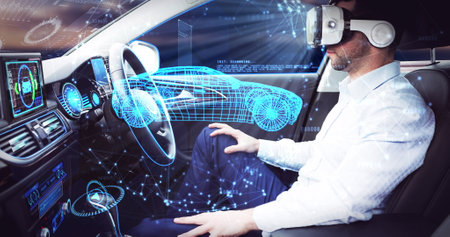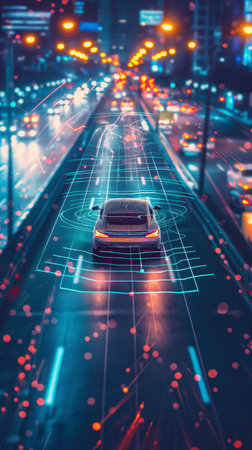Introduction to AI in the Automotive Industry
Artificial intelligence (AI) is revolutionizing the automotive industry in ways that are fundamentally transforming how Americans think about transportation. As we stand on the brink of a new era, AI-driven innovations are steering us toward a future where mobility is not only smarter but also greener and more sustainable. The integration of AI technologies into vehicles is already enabling advanced features such as self-driving capabilities, intelligent navigation, and real-time traffic management. These advancements are helping reduce carbon emissions, increase road safety, and optimize energy use across our cities and highways. In the United States, where car culture has long shaped daily life and economic growth, AI is paving the way for cleaner commutes, shared mobility solutions, and a reduced reliance on fossil fuels. The shift towards electric vehicles (EVs) and autonomous driving systems represents more than just technological progress—it signifies a collective move toward environmental stewardship and innovative urban planning. As we explore the role of artificial intelligence in self-driving car technology, it becomes clear that these developments are setting new standards for sustainability, efficiency, and convenience in American transportation.
2. How AI Powers Self-Driving Technology
The backbone of self-driving car technology is artificial intelligence, which orchestrates a symphony of advanced components to enable autonomous vehicles to safely navigate complex environments. At the heart of this innovation are three critical AI technologies: machine learning, computer vision, and sensor fusion. Each plays a distinct yet interconnected role in how self-driving cars perceive their surroundings and make split-second driving decisions that prioritize both safety and efficiency.
Machine Learning: The Brain Behind the Wheel
Machine learning algorithms allow self-driving cars to learn from vast amounts of data collected from real-world driving experiences. Through pattern recognition and predictive modeling, these systems continuously improve their ability to identify objects, predict pedestrian movement, and anticipate road hazards. This ongoing learning process helps vehicles adapt to new scenarios, making them smarter and more reliable over time.
Computer Vision: Seeing the Road Ahead
Computer vision acts as the “eyes” of the vehicle, processing input from cameras and interpreting visual information such as traffic signs, lane markings, and other vehicles. This technology enables the car to understand its environment in detail—recognizing everything from stoplights to bicyclists—ensuring accurate navigation even in challenging conditions like night driving or inclement weather.
Sensor Fusion: Making Sense of Every Signal
Sensor fusion combines data from multiple sources—including lidar, radar, ultrasonic sensors, and cameras—to create a comprehensive understanding of the vehicles surroundings. By merging these different streams of information, AI can detect obstacles, judge distances, and map out safe pathways with greater precision than any single sensor could achieve alone.
Key AI Components in Autonomous Vehicles
| Component | Main Function | Example Application |
|---|---|---|
| Machine Learning | Pattern recognition & prediction | Predicting pedestrian crossings at intersections |
| Computer Vision | Visual interpretation of surroundings | Reading speed limit signs & detecting traffic lights |
| Sensor Fusion | Merging multi-sensor data for accuracy | Avoiding obstacles by combining radar & camera inputs |
Toward Greener, Smarter Mobility
The synergy between these AI technologies not only enhances safety but also supports sustainability goals by enabling smoother traffic flow and reducing unnecessary emissions through optimized driving patterns. As AI continues to evolve within the self-driving sector, its potential for creating greener and more efficient transportation solutions becomes increasingly promising for communities across America.

3. Safety and Reliability of Autonomous Vehicles
Artificial Intelligence (AI) plays a pivotal role in transforming the safety and reliability of self-driving car technology, especially on American roads. By leveraging advanced machine learning algorithms and sensor fusion, AI systems can process massive amounts of data in real time—far beyond human capabilities.
Enhancing Safety Features
AI-driven autonomous vehicles are equipped with sophisticated safety features such as collision avoidance, lane-keeping assistance, and emergency braking. These features are powered by deep neural networks that continuously learn from millions of miles driven, both in simulations and real-world scenarios. As a result, AI enables vehicles to recognize pedestrians, cyclists, traffic signals, and unpredictable hazards with remarkable accuracy.
Reducing Human Error
Human error remains a leading cause of accidents on American highways and city streets. Self-driving cars utilize AI to minimize these errors by maintaining constant vigilance, reacting faster than any human driver could, and making split-second decisions based on comprehensive situational awareness. This not only reduces accident rates but also contributes to safer communities and more sustainable urban mobility.
Addressing Reliability and Ethical Challenges
Despite these advancements, the reliability of AI-powered autonomous vehicles faces ongoing challenges. Factors such as sensor limitations during harsh weather conditions or complex urban environments can affect performance. Furthermore, ethical decision-making becomes crucial when the AI must choose between difficult outcomes—like prioritizing passenger safety versus pedestrian protection. Ongoing research and transparent regulatory frameworks are essential to ensure these systems make fair, responsible choices aligned with American values.
The Road Ahead for U.S. Adoption
For widespread acceptance across the United States, automakers, policymakers, and tech companies must work together to address technical hurdles and build public trust in AI-driven vehicles. Ensuring transparency in how AI makes decisions and continually updating safety protocols will help Americans embrace this green technology as a cornerstone for smarter, safer transportation networks.
4. Environmental and Sustainability Impacts
As the United States continues to urbanize at a rapid pace, the environmental footprint of transportation is front and center in public discourse. Artificial intelligence, at the heart of self-driving car technology, holds significant promise for advancing sustainability goals within our cities. By harnessing AI-driven systems, autonomous vehicles (AVs) have the potential to revolutionize energy efficiency, slash emissions, and help shape smarter urban planning strategies.
Boosting Energy Efficiency
AI-powered self-driving cars are designed to optimize every aspect of driving—from acceleration and braking to route selection. Unlike human drivers, AI can process vast amounts of data in real-time, making calculated decisions that minimize fuel consumption or battery use. This level of precision reduces unnecessary stops, idling, and aggressive maneuvers that typically waste energy. For example, a network of AVs communicating with each other can smooth out traffic flow, leading to fewer traffic jams and better average fuel economy across the board.
Decreasing Emissions
The reduction of greenhouse gas emissions is one of the most significant environmental benefits associated with AI-driven vehicles. Autonomous cars can be programmed to operate within optimal speed ranges and coordinate with city infrastructure such as smart traffic lights, further decreasing time spent in congested conditions. The table below highlights how self-driving technology compares to conventional vehicles in key sustainability metrics:
| Vehicle Type | Average Fuel Efficiency (MPG/MPGe) | CO2 Emissions (g/mile) | Idle Time Reduction (%) |
|---|---|---|---|
| Traditional Gas Vehicle | 25 MPG | 404 g/mile | 0% |
| AI-Driven Hybrid/Electric AV | 50 MPGe+ | <100 g/mile | 30-50% |
Supporting Sustainable City Planning
The integration of AI-based self-driving cars into city ecosystems opens new doors for sustainable development. With advanced data analytics, urban planners can model traffic flows, design more efficient road networks, and even repurpose parking spaces as green zones or affordable housing. AI’s predictive capabilities also enable dynamic adjustments to public transit schedules and ride-sharing programs, reducing single-occupancy vehicle trips and supporting a greener urban lifestyle.
A Greener Tomorrow: Challenges and Opportunities
While the potential is immense, realizing these benefits on a national scale will require careful coordination among policymakers, tech companies, and communities. Equity considerations must ensure that all Americans have access to these green technologies. As we look ahead, the role of artificial intelligence in self-driving car technology is not just about convenience—it’s about building resilient cities that prioritize people and planet.
5. Challenges and Ethical Considerations
As artificial intelligence continues to transform self-driving car technology, several challenges and ethical considerations come to the forefront—issues that resonate deeply with American cultural values.
Privacy Concerns
Autonomous vehicles rely on vast amounts of data collection, including location tracking, driving habits, and even in-cabin monitoring. In the U.S., where personal privacy is a fundamental value, ensuring robust protections against misuse or unauthorized access to this sensitive information is essential. Transparent data handling policies and user consent mechanisms are crucial for building public trust.
Liability and Responsibility
The question of who is liable in the event of an accident involving a self-driving car remains a contentious issue. Should responsibility fall on the vehicle owner, the manufacturer, or the software developer? This ambiguity presents significant legal and insurance challenges, demanding clear regulations that protect both consumers and innovators while aligning with American notions of justice and accountability.
Cybersecurity Threats
With AI-driven cars connected to networks, they become potential targets for cyberattacks. Protecting these vehicles from hacking is vital not only for individual safety but also for national security. The U.S. places a high priority on cybersecurity, so manufacturers must implement advanced safeguards and respond rapidly to emerging threats to maintain confidence in autonomous transportation systems.
Societal Implications
The widespread adoption of self-driving cars will reshape American society in profound ways—from altering job markets (such as trucking and taxi services) to changing urban planning and environmental impacts. While AI can promote sustainability through optimized driving patterns and reduced emissions, it is imperative to ensure that these advancements benefit all communities equitably, minimizing unintended consequences like increased unemployment or exacerbated social divides.
Toward Responsible Innovation
Addressing these challenges requires collaboration between tech companies, policymakers, and communities. By prioritizing privacy, clarifying liability, strengthening cybersecurity, and considering broad societal impacts, the U.S. can harness AIs potential in autonomous vehicles while upholding its cultural values of fairness, security, and sustainability.
6. The Road Ahead: AI, Policy, and Public Acceptance
As artificial intelligence continues to steer the self-driving revolution, the path forward in the United States is shaped not only by technological progress but also by the evolution of policy and public sentiment. Federal and state governments are working diligently to establish comprehensive regulatory frameworks that balance innovation with safety and sustainability. Initiatives from the U.S. Department of Transportation and National Highway Traffic Safety Administration (NHTSA) set clear guidelines for testing and deployment, ensuring AI-driven vehicles meet rigorous safety standards while promoting green mobility solutions.
Building public trust remains a cornerstone of widespread adoption. Transparent communication about how AI systems work, combined with ongoing education campaigns, helps demystify autonomous technology for American communities. Local governments and industry leaders collaborate on pilot programs to showcase real-world benefits—such as reduced emissions, fewer accidents, and improved accessibility—highlighting how intelligent transportation can contribute to cleaner air and healthier cities.
Looking ahead, sustainable urban planning will increasingly integrate AI-powered vehicles with renewable energy infrastructure. Policymakers prioritize investments in smart grids, electric charging stations, and eco-friendly road designs to support a future where self-driving cars operate efficiently within greener environments. By championing both technological innovation and environmental stewardship, America sets a global example for responsible, people-centric mobility.
Ultimately, the synergy between advanced AI, thoughtful regulation, and community engagement paves the way for a transportation ecosystem that’s not only smarter and safer but also more inclusive and sustainable for generations to come.

